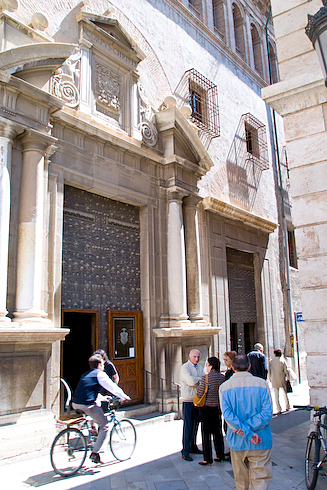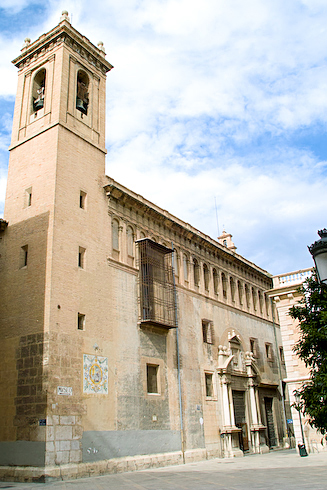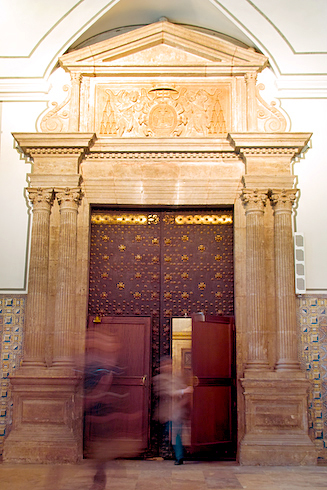Note: This is the second in a series of posts about The Real Colegio del Patriarca — a building we intending to explore in depth. If interested, read our earlier post about it:
Colegio del Patriarca – Introduction & History
Facade
A tourist strolling down Calle la Nave would be forgiven for going right past the Colegio del Patriarca without noticing it. From the street, the building is not much to look at. Severe, unadorned stone comprises the building’s four walls, lacking any striking features. The Colegio resembles nothing more than a heavy brick, dropped into the center of the city. Arches running along the south and west sides do add some levity, but the effect is minimal.
The most interesting feature of the facade is the massive twin doors — and those are unfortunately situated within spitting distance of the beautiful University building, La Nau. As detailed in the introduction, the Colegio houses two separate functions, a seminary and a chapel, and each has its own giant wooden door. It’s easy to guess which is which. The door on the right side is unassuming and functional, with no unnecessary bits & pieces. But the left-side door is ornate — designed to impress.

The chapel door is bordered with 4 marble columns, and crowned by a detailed sculpture of the Patriarch’s coat of arms. The coat of arms features a golden chalice and the patriarchal cross & cap, along with an inscription from Genesis: “And what shall I do now unto thee, my son?” This is the emblem of the Colegio, and found repeatedly within its walls.

Above the coat of arms, you’ll see the Colegio’s original name, “Corpus Christi”, as well as the year of its inauguration, 1603.
Atrium
Let’s step inside the door. Look toward the ceiling, and you’ll notice a large fresco, painted in 1610 by Bartolomé Matarana. His work can be found elsewhere on the grounds.

The entrance to the chapel is, naturally, impressive. It’s made of Corinthian stone and shares features of the larger, outer door: grooved columns and the coat of arms. And like the outside doors, this one is made of Austrian pine, with brass handles and bronze nailing.
You might notice something else on your visit. Something which seems a little out of place in the atrium of a chapel. Something like a gigantic, preserved alligator mounted on the wall above the holy water. Meet “The Dragon of the Patriarch”… whose legend we’ll detail in this series’ next post.

Related:
Colegio del Patriarca – Introduction & History


Pingback: Colegio del Patriarca Video - Bell Tower in Action | Hola Valencia Blog
Pingback: Bed and Breakfast: B&B Mare de Deu | Hola Valencia Blog
Pingback: At the MuVIM: Valencia ABC, Hungarian Advertising | Hola Valencia Blog